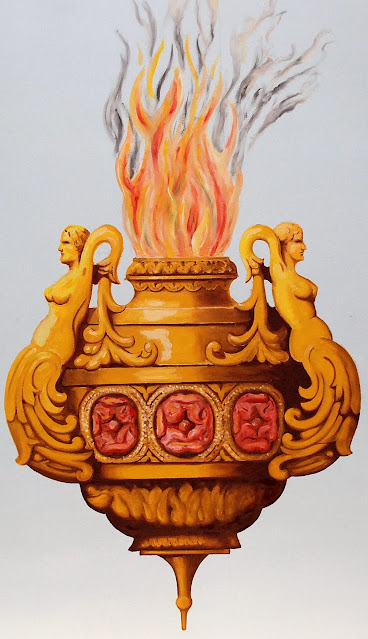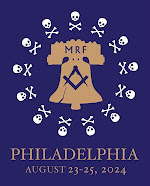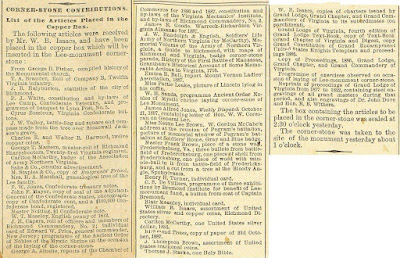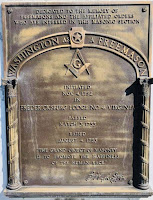 |
| J. Wright photos |
Saturday, January 15, 2022
‘Google Pixel & Illuminati Brotherhood’
We’re not supposed to brag about these things, but this is too incredible to keep quiet. So, you’ve been seeing new ads for Google’s Pixel 6 in recent months, but did you spot the Illuminati Brotherhood ring?
It’s super fast! It’s subliminal (of course!). He’s wearing it “points in” and on the finger denoting Supreme Hierophant rank of the 99th Degree, so this is heavy business, but it’s there for the initiated eye to see.
Tuesday, January 11, 2022
‘Dusting off the Pot of Incense’
 |
| Magpie file photo |
For the second time in two weeks, the Master of my lodge called on me to lead an educational discussion for the brethren. This is a very singular occurrence! Publicity Lodge actually didn’t hold an in-person meeting last night, opting instead for a Zoom gathering as New York City adjusts to the latest virus variant. (Only a few of us seem to understand how these variants will vary in perpetuity, so we might as well resume normalcy, but that’s another story.) Because my talk on mindfulness exercise last month on St. John’s Day went over okay, I thought I should double down and dust off my old presentation on the Pot of Incense as a Masonic symbol.
Actually, this was an abbreviated version of the original, at about half the length, that I had to read because it had been so many years since I last presented it. Rather than summarize it for you here, I hoped to link to some previous edition of The Magpie Mason that spells it all out, but I guess I never wrote that blog post. All I got is this from ten years ago. But “The Emblem of a Pure Heart” gives a history of incense’s ritual usages, several verses from the Hebrew Bible, bits of arcane Masonic rituals, quotations from natural philosophers of centuries past, and some suggestions for how to incorporate the burning of incense in our lodge meetings today—and that’s when things got interesting.
The brethren love the idea of adding a gentle amount of frankincense aroma at the Inner Door, when the candidate enters the worshipful lodge, and again at the altar upon being obligated. I made the case for the sense of smelling, in addition to being explained in the lecture of the Second Degree, also is a catalyst for recollecting vivid memories. One of the brethren listening said there are scientific data linking olfactory stimuli to the eliciting of old memories. So I’m envisioning our use of incense will plant meaningful impressions in our initiates that will re-emerge every time that familiar scent appears, and that all the brethren will share the experience.
While I was speaking, the Brother Secretary went online and procured a gizmo that vaporizes frankincense oil, so we’ll be able to enjoy the aroma, but without generating any smoke. (One of our most venerable Past Masters explained that it is possible to have our smoke detectors switched off temporarily, but it’s a complicated arrangement requiring the building management’s attention. The vaporizer will more than suffice.) My personal preference would be to load my censer with smoldering charcoal and roasting resins to fill the space with glorious plumes of aromatic smoke—but I can’t because I don’t own the place.
While preparing for last night’s discussion, I hacked away at the text to make it somewhat brief, and I deleted information I ought to have kept, and I kept stuff I could have done without. I omitted Thomas Reid(!) on the sense of smell, but retained Rene Descartes, when I should have done the reverse. Small matter. What’s more important is Publicity Lodge will initiate four petitioners on February 7 with an enhanced ambiance that further emphasizes the crossing into a new community, a new consciousness.
Maybe one future night, after I’m long gone, one of these Apprentices (perhaps a Past Grand Master by then) will attend a degree at Publicity, and will be returned to that first Monday of February 2022 thanks to a familiar scent—coming from some AI app downloaded into his olfactory cortex.
My thanks to Worshipful Master Diego and to all the brethren. I feel like I finally accomplished something in Freemasonry.
Labels:
Masonic Hall,
Pot of Incense,
Publicity Lodge M,
Thomas Reid
Sunday, January 9, 2022
‘Reading the minutes (from 1598)’
“But why do we have to read the minutes?”
“Because they’re the first draft of history, and we have to ensure their accuracy. And because not everything is about you.”
The dialogue above is excerpted from a ritual (sic) I’m writing for a certain Scottish Rite (sic) jurisdiction. In this scene, the newly initiated George Washington complains to Worshipful Master Teddy Roosevelt about the humdrum nature of their lodge’s meetings. Just as TR is about mete some Big Stick wisdom, none other than Jacques DeMolay saunters along, and imparts the rejoinder that young Washington groks immediately.
“And tomorrow,” DeMolay continues, “on Veterans Day itself, when we Sir Knights sign the Proclamation of Independence, history will be made too!”
This is still an early draft, but what is not susceptible to revision is the earliest known page of Masonic meeting minutes. Speaking of the Scottish, on this date* in 1598, the Masons of Lodge Aitchison’s Haven “maid” Entered Apprentice Robert Widderspone a “fellow of Craft.” (These are operative stone masons.)
What has been bequeathed to us is not evidence of a first Masonic meeting because, obviously, something must have preceded this. Nor is it indicative of a first Masonic lodge, because two others over there claim to antecede Aitchison’s Haven. This “merely” is our oldest known record of Masonic proceedings, and, at age 424, that’s pretty cool.
(Both images courtesy Grand Lodge of Scotland.)
*We today use a different calendar, so just play along.
Labels:
GL of Scotland,
Lodge Aitchison’s Haven,
minutes
Saturday, January 8, 2022
‘Lodge of St. Peter & Harmony 600’
This just in: Another special interest lodge in England devoted to the brethren’s enjoyment of real ale and craft beer will be launched Wednesday, March 2. But Lodge of St. Peter & Harmony 600 is not a new lodge by any means.
Inspired by how the Masonic Craft Beer Society revivified Horus Lodge 3155 in London, the brethren here are incorporating their Goose & Gridiron social club into their lodge. Harmony Lodge 600 dates to February 4, 1852. Lodge of St. Peter 6509 was warranted May 7, 1947. These lodges amalgamated December 11, 2002, continuing Masonic tradition in Bradford, Yorkshire.
The lodge will meet on the first Wednesdays of March, June, July, and October as a working lodge—making Masons, conducting usual business, and hosting festive boards. It simply will have this focus on the study and appreciation of real ales and craft beers. The lodge’s bar will be stocked accordingly, and the brethren will host speakers from area breweries for their enlightenment.
On one special upcoming day, they will charter a steam train to “socialize, enjoy local beers, and have a fish and chips supper, all whilst traveling up and down the line on a historic steam hauled train.”
Bravo! Vivat!
Friday, January 7, 2022
‘Fire destroys Ohio Masonic landmark’
 |
| Zanesville Times Recorder |
Flames consumed the six-story Zanesville Masonic Temple in Ohio late last night, local media are reporting, leaving only the exterior walls, which will have to be demolished if they don’t fall on their own. No fatalities nor injuries have been reported.
One man, found hanging out a third floor window, was rescued, as were an unknown number of animals inside.
Zanesville is a city of approximately 25,000, and is situated 52 miles east of Columbus. This awful news comes one week after a suspicious fire damaged the headquarters of the Grand Lodge of Ireland in Dublin.
Comments on social media say officer jewels made by Paul Revere were among the artifacts lost to the flames.
Located on North Fourth Street, it was home to Lodge of Amity 5 and other Masonic groups, plus a number of small businesses and artist and performance spaces. The building, no longer owned by a Masonic entity, was constructed 1902-03, and was added to the U.S. National Register of Historic Places in 1990. Its exterior was Renaissance Revival; the interior was the Egyptian Revival style that was popular at the turn of the century.
The spectacular blaze was so powerful that nearby buildings had to be evacuated, including the county jail, according to several local media reports. Streets surrounding the temple are closed in anticipation of the remnant’s demolition, meaning neighboring businesses and other entities are on hiatus.
The smallish municipality also is home to another Masonic temple, about five miles from the destroyed site, where La Fayette Lodge 79 and other bodies meet.
Donald Mason, mayor, is a Past Master of the lodge.
 |
| Issue 34 of JTMS. |
Lodge of Amity will reach its 210th anniversary a week from tomorrow. Among its famous roll is Hudson River School artist Thomas Cole.
Tuesday, January 4, 2022
‘Are you free for dinner?’
Masonic Week draws near—next month, in fact—and registration for our events is open. The anchor of the multifaceted affair is the Masonic Society dinner on Friday, February 11. It’ll be a big deal!
We will seat our new President, and the new Second Vice President, and two new members of the Board of Directors. Plus, more surprise announcements.
Our after dinner speaker will be Bro. Chris Ruli, Grand Historian and Librarian of the Grand Lodge of the District of Columbia. Chris will give us just the facts concerning “Masonic Myths of Our Nation’s Capital.”
The dining fee is $55 per person, and attendance is open to all Freemasons, our ladies, and friends of Freemasonry. (And, for a hotel, the food is good.)
 |
| Oscar Alleyne |
Founded in 2008, the Masonic Society is an independent 501(c)(3) educational foundation that publishes the quarterly periodical The Journal of the Masonic Society. Membership, at $45 annually, is a source of pride, many brethren inform me. (The hand-stamped, wax-sealed parchment each of us receives itself prompts accolades.)
The Journal is a beautifully designed and thoughtfully balanced mix of educational papers, speculative writings, news, opinion, photography and more. (We call it the Time magazine of Freemasonry, if you’re old enough to get that reference.)
Again, click here to join us for dinner and conversation on Friday, February 11 at Masonic Week in Arlington, Virginia. Vivat!
Labels:
Chris Ruli,
Masonic Society,
Masonic Week,
Oscar Alleyne
Monday, January 3, 2022
‘MRF. Detroit. April.’
It’s okay if I say it this time: The Masonic Restoration Foundation will host its eleventh symposium at the Detroit Masonic Temple April 1-3. Registration here will open Friday, January 14.
Sunday, January 2, 2022
‘Everybody smiles’
Keeping things lighthearted to start the year, you can’t get much more easygoing than making everybody smile, can you?
Worcester Art Museum in Worcester, Massachusetts has on exhibit one of those rare sets of silver jewels for lodge officers crafted by Paul Revere.
Revere was born January 1, 1735. He was initiated in St. Andrew’s Lodge, a Scottish lodge in Boston, in 1760. He served five terms as Worshipful Master there (plus four in another lodge), and was a Grand Lodge officer for many years. These pieces were made in 1793, two years before he became Grand Master, for the newly instituted (their term) Morning Star Lodge in Worcester.
As you can see, both Deacons’ jewels are inscribed with “Omnibus Arridet,” Latin for “everybody smiles.”
I don’t know what the motto might mean for the lodge. Was it designated to the Deacons because they are the messengers, and a happy countenance is preferable when attending to alarms? Although…
Paul Revere is known to history as an American patriot and as both an artisan silversmith and an artist engraver—but as a young man he became a dentist! During lean economic times in 1760s Boston, the peacetime following the French and Indian War, Paul Revere was in troublesome debt. To get by (and keep his house), he needed what the kids today call a “side hustle,” and so he learned how and then advertised his services as one who could fashion false teeth, at least for the front, using animal bone and ivory. “Everybody smiles” would be a smart tag line for a dentist’s ad campaign.
Seriously though, there is a Latin saying wrongly attributed Marcus Aurelius:
Mors nobis omnibus arridet, homo omnis hoc risum lenem redeuntem facere potest.
Or (maybe):
Death smiles at us all, all man can do is just smile back.
It seems these are good times for Morning Star Lodge. One of the Past Masters was installed Deputy Grand Master last week, and one of their own is the new DDGM. I bet they’re all smiling.
The collection of jewels is on long term loan, as part of a broader exhibit of Revere’s silversmithing, so there’s no need to rush today (although admission is free on first Sundays). Find them in the American Decorative Arts Gallery on the third floor.
WAM is open Wednesday through Sunday, 10 a.m to 4 p.m. 55 Salisbury Street in Worcester.
Click here to see King Hiram’s Lodge’s Revere jewels.
Saturday, January 1, 2022
‘Quiet enjoyment of this interesting hobby’
Happy New Year! And I insist on making the first edition of The Magpie Mason of 2022 a benign post to ballast the recent news of death and destruction that made last month a grim conclusion to a year that wasn’t all that great to begin with.
Nevertheless, it was that obituary of Tom Jackson the other day that prompts this post. I had mentioned how Brazil’s postal service issued a stamp several years ago honoring Tom, and that reminded me how, despite many posts on Masonic philately over the years, I never told you about The MPC Magazine.
Originally, in 1976, the Masonic Philatelic Club of Great Britain, and, later, the Masonic Philatelic Club, it today is the publisher of the quarterly magazine. Membership is open to all who seek the “furtherance of Masonic research via the media of postage stamps, the dissemination of knowledge gained, and the quiet enjoyment of this interesting hobby.”
And, really, who couldn’t benefit from quiet enjoyment of just about anything right now?
The January issue is available, and on the cover is none other than Bro. Harry Houdini, a historic Freemason from St. Cecile Lodge 568 in Manhattan. Bro. Howard Thurston (thanks, Brent!), a historic Freemason from Manitou Lodge 106 in Manhattan.
The annual subscription costs £15 for us Americans.
Friday, December 31, 2021
‘Fire at Grand Lodge of Ireland’
UPDATE: Tuesday, January 4:
 |
| thejournal.ie |
UPDATE: The Irish Times reports:
- “Anti-vaccination graffiti” in blue paint was found on the sidewalk outside the building.
- A man was observed breaking into the building and possibly lighting a Christmas tree afire inside the library.
- The unidentified man, said to have fallen, is hospitalized with spinal injuries.
- Police ask the public for any video recordings that may show the incident.
One unidentified man was reported injured seriously in a fire tonight inside Freemasons’ Hall, the headquarters of the Grand Lodge of Ireland, located on Molesworth Street in Dublin.
News media have been reporting one room was damaged badly, and that arson is suspected. The site is being examined, and an investigation is underway.
‘And give us a hand o’ thine’
Finally, this year is done, but not before a teamwork of media and academia boasts of an achievement in historical research that you and I have known all along.
Today’s Evening Standard and a growing number of other outlets report how a Scottish scholar, who specializes in anthropological and sociological facets of music, has “discovered” that the tradition of locking arms while singing Bro. Robert Burns’ “Auld Lang Syne” began with…the Freemasons!
Hmmm, you don’t say.
Read all about it here.
That’s it for me, brotherans. Signing off for 2021, and wishing all of you a Happy New Year that won’t suck nearly as much as did this annus horribilis.
Labels:
Evening Standard,
music,
New Year's,
Robert Burns
Thursday, December 30, 2021
‘RW Thomas Jackson, R.I.P.’
 |
| Magpie file photo |
In speech after speech, essay after essay, book after book, Jackson held up a mirror to his brethren, challenging us to recognize how Freemasonry’s loss of prestige in society stems precisely from the initiate first, ask questions later mindset that has given lodges an uninspiring generic fraternal club personality. “Essentially, we don’t know our origins, but Freemasonry attracted some of the greatest men of the last 300 years,” he often said. “Did Freemasonry make men great, or did great men make Freemasonry? I say it is both. Voltaire, Mozart, Haydn, Franklin, and Washington were men we wanted to be associated with. That is our deficit today in North America. Where are the Mozarts of today? My role is to preserve Freemasonry in case great men come later.”
He did more than keep the lights on; Tom Jackson reflected the Light. He showed a path forward.
In his home state, he labored as Grand Secretary for nineteen years. He was a principal in Pennsylvania’s research lodge, its first Observant lodge, and, of course, its Academy of Masonic Knowledge. (I believe it was at PAMK where we first met twelve or more years ago.) At the national leadership level, Tom was, among many other things, a Blue Friar (No. 93), a prolific book reviewer for ages in The Northern Light, and a tireless traveler from conference to symposium to lodge meeting, ceaselessly evangelizing his inspiring message of how you and I can restore Freemasonry’s magnificence if we only would follow the clear teachings we received in the first place.
Tom Jackson’s ideas were not always welcome. Buy me a beer sometime, and I’ll tell you about the harrowing threat he received several years ago.
Nor did his influence stop at our nation’s shores; Tom, in effect, was the leader of the World Conference of Masonic Grand Lodges, albeit reluctantly, for years. Brazil, where Freemasonry is revered, put him on a postage stamp, for heaven’s sake.
Thomas Jackson was a Founding Fellow of the Masonic Society.
Please remember Linda, his wife of 56 years, in your devotions. I don’t doubt Cumberland Valley Lodge 315 will conduct a Masonic obsequy. It’ll be well attended.
“He was a man. Take him for all in all. I shall not look upon his like again.”
‘With the solemn and imposing rites of Masonry’
 |
| A 1908 photo of the monument, which was completed in 1890. |
Still curious about the time capsule opened Tuesday in Virginia (see post below), I peered into the Masonic history there to learn more. I shouldn’t be surprised, although I am, to find out this wasn’t merely Freemasonry donating items for inclusion in a time capsule, but the cornerstone ceremony was a Masonic rite. And requested by the governor at that.
As I mentioned yesterday, that time capsule dates to October 27, 1887. On December 12 of that year, the Grand Lodge of Virginia convened in St. Alban’s Hall in Richmond for its 110th Annual Communication at which time Grand Master William F. Drinkard recollected to the brethren how the Craft became involved. The following comes from the Book of Proceedings:
On the 27th of October I laid the corner-stone of a monument to be erected in this city to the memory of General Robert E. Lee. This was done at the request of the Lee Monument Association, whose Board of Managers is presided over by the Governor of Virginia, himself a Lee. Governor Lee wrote me a letter stating that it was the wish of the Board that the corner-stone of the Lee Monument should be laid, to use his own words, “with the solemn and imposing rites of Masonry.”
 |
| Fitzhugh Lee |
The occasion was one that no considerations of inclement weather, or of personal inconvenience or discomfort, could have caused the people of Virginia to neglect or overlook. As when the corner-stone of City Hall was laid, so when the corner-stone of the Lee Monument was laid, the Knights Templar most thoughtfully and generously tendered their services as an escort to the Grand Lodge, and entitled themselves to the credit of having done more than any other one organization to render the ceremonies what [Governor] Lee described them as being—namely, “solemn and imposing.” These are our brethren, and therefore I have deemed it proper for the Grand Master to mention their services. I leave it to others to name the many distinguished gentlemen from all parts of the Union who witnessed and participated in so much of this memorable work as was not under the control of the Masons.
 |
| The first Lincoln statue, dedicated 1868. |
Anyway, the Grand Lodge of Virginia’s outlay stemming from the Lee Monument that dreary October day totaled $235.32. That’s fourteen dollars more than what it expended for the City Hall cornerstone ceremony. It was a lot of money. In contrast, the Grand Treasurer’s salary that year was $300. It is impossible to transubstantiate the $235 into today’s worthless currency, but in the gold coins of that time, the gold would weigh about eleven ounces, which this morning costs $19,811.
In review of MW Drinkard’s speech, the Grand Lodge’s Special Committee on the Address of the Grand Master reported, in part:
It has been always one of the most impressive teachings of Free Masonry to pay the full measure of honor to those to whom honor is justly due, and for ages they have exemplified this sentiment by laying the corner-stones of monuments erected to testify the admiration of mankind for those virtues which have merited such distinctions.
No occasion in the history of this Grand Lodge has afforded a more sincere and heartfelt satisfaction to the great body of the patriotic Masonic sons of our Ancient Commonwealth than that which afforded them the privilege of participating in the ceremonies of laying the corner-stone, on the 27th day of last October, of a monument designed to faintly express the unmeasured love and the profound admiration which fills every breast within the confines of Virginia for the illustrious man, General Robert E Lee, our State gave to stand, for time, before the world, the exemplar and the monument of every patriotic and heroic virtue.
We congratulate our brethren, that they lived to participate in the proceedings mentioned by the Grand Master.
Wednesday, December 29, 2021
‘Masonic relics discovered!’
That’s a little hyperbole. The “relics” are common items, but it is pretty cool that they were recovered yesterday from within a time capsule.
Monument Avenue in Richmond, Virginia has been undergoing a change recently as its statues memorializing Confederate generals are coming down. The largest Confederate statue in America, a Robert E. Lee atop a 20-foot pedestal, has been retired, leading to the discovery of two time capsules dating to October 27, 1887.
One of the boxes was found inside that mammoth stone plinth. It had been secreted therein by the laborers who erected the giant general. The other, which was opened and explored yesterday, was beneath the monument. It contained many items of local historical interest, including books and other artifacts of Virginia Freemasonry’s post-Civil War era.
The truth is no Masonic historian deserving of the title would be at all surprised to find Masonic contributions to a time capsule from late nineteenth century Virginia, but it is comforting to know how the fraternity was so significant that this time capsule, which is smaller than a milk crate, would include multiple proofs that Hiram was there. More info here. (Of course, Richmond is home to Masons’ Hall, which already was more than a century old when this box was buried.)
There is a Grand Lodge Book of Proceedings. And a Grand Chapter of Royal Arch book. A small Templar pamphlet from Richmond Commandery 2 looks like a membership roster. (At that time, Richmond 2 met on fourth Tuesdays, and yesterday was the fourth Tuesday, although I doubt the Sir Knights met between Christmas and New Year’s.) Tucked inside this document is a KT calling card from Past Eminent Commander James Hamilton Capers, who would become R.E. Grand Commander in 1897. There also is a Grand Lodge certificate of some kind. And then there’s a palm-size Square and Compasses made of wood.
The time capsule is made of copper. It was not watertight, so its contents today are waterlogged, but still in good shape it seems. The metal objects (coins, tokens, musket balls) will clean up well, but the organic (books, papers) items? We’ll have to see what the Virginia Department of Historic Resources can manage. Archaeological Conservator Katherine Ridgway said the contents are “more waterlogged than we had hoped, but not as bad as it could have been.”
All in all, not a bad day for those of us who understand Freemasonry today by knowing its yesterdays.
 |
| Calling card of Sir Knight James Hamilton Capers, who would become R.E. Grand Commander in 1897. (CBS News) |
CBS News covered the event yesterday and shares several videos of different lengths on YouTube from which I did my best to capture the photos shown here.
That two time capsules were embedded within and beneath the Lee colossus indicates to me that the people of Richmond anticipated their hero’s effigy falling one day, and I’d like to think they’d be delighted to know it survived well into the twenty-first century.
UPDATE: Courtesy of Bro. St. Ecker in Virginia, I can share this newspaper clipping. The W.B. Isaacs mentioned in the lede was Grand Secretary of the Grand Lodge.
Tuesday, December 28, 2021
‘Cervisia Lodge for zythophiles’
A second (as far as I know) lodge for zythophiles is being organized under the United Grand Lodge of England.
You remember Horus Lodge in London from earlier this year; now, Cervisia Lodge seeks worthy and well qualified brethren for quaffing in the Province of Northamptonshire and Huntingdonshire (about seventy miles due north of London).
Details are scant, but for information, feel free to make contact here.
Cervisia of course is Latin for beer. When framing to pronounce it, there is a temptation to rhyme with the Spanish cerveza, but there is no soft C in Latin so speak it as a K, as with collegia. Also, the V is spoken as our English W. (I’m assuming that’s how the lodge intends it.)
I don’t know what they’re having for breakfast over there, but the UGLE is chartering lodges like it’s the ’80s again—the 1780s. Not necessarily a sign of overall membership growth, but a result of Masons already in good standing gathering for the “innocent mirth” (e.g., beer, sport, cars) enshrined in the first Book of Constitutions, while keeping Freemasonry the “Center of Union.”
Best of luck to Cervisia Lodge!
Monday, December 27, 2021
Saturday, December 25, 2021
Wednesday, December 22, 2021
‘Restore a Founding Father’s foundation’
Nearly 200 miles northwest of Masonic Hall is the Town of Vestal, New York, in the vicinity of Binghamton, and home to St. Mark’s-Vestal Lodge 435. Our brethren there aim to raise $10,000 to make necessary repairs to the statue of Masonic George Washington that watches over the lodge’s section of Vestal Hills Memorial Park, a renowned cemetery that reached its ninetieth year in 2021.
In need, specifically, is a replacement foundation for the statue, the original stone plinth and its wide, stepped base having suffered substantially since its installation in 1937. Click here for media coverage that shows the damage.
Titled “Washington As a Freemason,” the monument renders our historic brother wearing an apron and wielding both trowel and gavel; a large bronze tablet gives the dates of his progress through the Craft degrees at Fredericksburg, Virginia.
While Washington always was revered in a younger America, the 1932 bicentenary of his birth was a massive cultural event that spanned that decade, encompassing everything from his likeness being added to the quarter-dollar to countless local commemorations such as, I surmise, this statue. (Grand Lodge acquired DeWint House in 1931, something in which my lodge played a part that I have to research one day.)
Of course this isn’t the optimal moment to request money for non-emergency contingencies, but the lodge uses GoFundMe to reach the ambitious goal. Perhaps you or your lodge or the lodge’s charity fund or other Masonic bodies could assist. Basically, thirty cents from each New York Mason would capitalize the project fully.
Not to distract from the point of this worthy cause, but it should be understood that statues of Washington (and plenty of others) that stand on public lands will be made extinct in our lifetime, and maybe even sooner than I suspect. Those monuments erected on private properties can survive, assuming they’re not attacked by mobs, and it is imperative they always be preserved and protected to demonstrate how Americans care about their heritage and their posterity. End of lecture.
Maybe you could share the link to GoFundMe and the burden of reviving this statue can be shared by more than only the local Masons out there.
Subscribe to:
Posts (Atom)





























































































